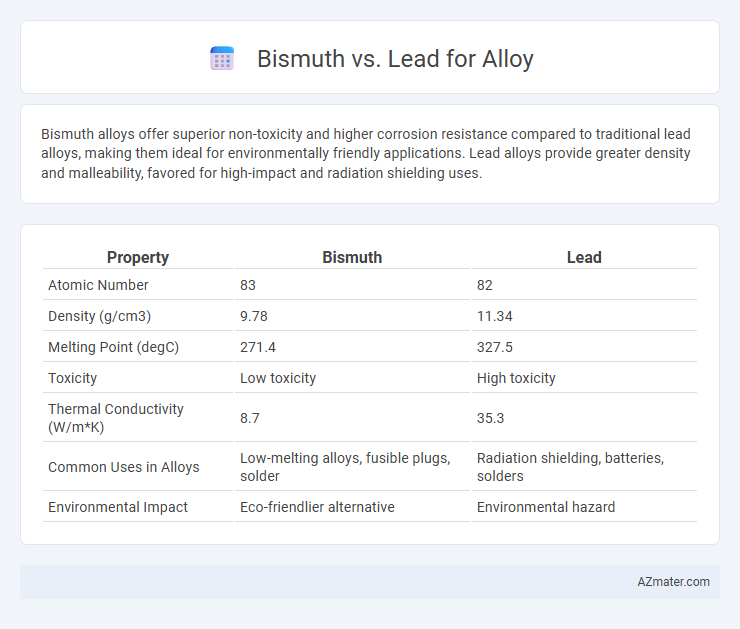Bismuth alloys offer superior non-toxicity and higher corrosion resistance compared to traditional lead alloys, making them ideal for environmentally friendly applications. Lead alloys provide greater density and malleability, favored for high-impact and radiation shielding uses.
Table of Comparison
| Property | Bismuth | Lead |
|---|---|---|
| Atomic Number | 83 | 82 |
| Density (g/cm3) | 9.78 | 11.34 |
| Melting Point (degC) | 271.4 | 327.5 |
| Toxicity | Low toxicity | High toxicity |
| Thermal Conductivity (W/m*K) | 8.7 | 35.3 |
| Common Uses in Alloys | Low-melting alloys, fusible plugs, solder | Radiation shielding, batteries, solders |
| Environmental Impact | Eco-friendlier alternative | Environmental hazard |
Introduction to Bismuth and Lead Alloys
Bismuth and lead alloys are widely used in industries requiring low-toxicity, high-density metals with unique melting properties. Bismuth alloys are favored for their non-toxic, environmentally friendly characteristics, superior machinability, and low melting points ideal for safety devices and fusible plugs. Lead alloys offer excellent corrosion resistance and high density, making them suitable for radiation shielding and batteries, though concerns regarding lead toxicity drive the search for safer bismuth alternatives.
Physical Properties Comparison
Bismuth exhibits a lower density of 9.78 g/cm3 compared to lead's 11.34 g/cm3, making bismuth-based alloys lighter. Bismuth has a melting point of 271.5degC, significantly higher than lead's 327.5degC, affecting alloy solidification and thermal stability. Both metals are highly malleable and exhibit excellent corrosion resistance, but bismuth alloys often display superior brittleness and lower ductility relative to lead alloys.
Melting Points and Casting Behavior
Bismuth alloys typically have lower melting points, around 138degC to 271degC, compared to lead alloys which melt between 327degC and 330degC, making bismuth preferable for low-temperature casting applications. Bismuth exhibits excellent casting behavior with minimal shrinkage and good fluidity, providing precise mold filling and fine detail reproduction. Lead alloys, while offering higher melting points and durability, tend to have more shrinkage and require higher casting temperatures, impacting energy efficiency and mold wear.
Environmental and Health Considerations
Bismuth is favored over lead in alloys due to its significantly lower toxicity and minimal environmental impact, making it a safer alternative in manufacturing and plumbing applications. Lead alloys pose serious health risks, including neurological damage and contamination of water sources, leading to stringent regulations and reduced usage. The non-toxic nature of bismuth alloys enhances workplace safety and reduces hazardous waste concerns, aligning with global efforts for sustainable and eco-friendly materials.
Mechanical Strength and Durability
Bismuth alloys exhibit superior mechanical strength and enhanced durability due to their lower toxicity and improved corrosion resistance compared to lead alloys. Lead alloys tend to have lower tensile strength and are more prone to deformation under stress, reducing their effectiveness in high-load applications. The higher hardness and non-ductile nature of bismuth-based alloys contribute to longer service life and reliability in industrial components.
Applications in Industry
Bismuth-based alloys are preferred over lead in industries requiring non-toxic, environmentally friendly alternatives, such as in pharmaceuticals, cosmetics, and food processing equipment. Lead alloys, known for their high density and radiation shielding properties, remain dominant in battery manufacturing, ammunition, and nuclear industry applications. The substitution of lead with bismuth in alloys also benefits electrical and plumbing components due to bismuth's lower toxicity and biodegradability.
Cost and Availability
Bismuth is generally more expensive than lead due to its lower natural abundance and more complex extraction process, impacting overall alloy production costs. Lead remains widely available and cheaper, benefiting from well-established mining and recycling infrastructures that ensure steady supply for alloy manufacturing. Choosing bismuth over lead in alloys often involves balancing higher material costs against lead's environmental and toxicity concerns.
Performance in Ammunition and Ballistics
Bismuth alloys outperform lead in ammunition by offering non-toxic alternatives with comparable density and melting points, enhancing environmental safety without sacrificing ballistic performance. Bismuth's higher hardness improves penetration and reduces barrel fouling, contributing to extended firearm lifespan and consistent shot patterns. The substitution of lead with bismuth in shot pellets maintains effective energy transfer and accuracy while meeting regulatory restrictions on hazardous materials in hunting and shooting sports.
Corrosion Resistance and Chemical Stability
Bismuth alloys exhibit superior corrosion resistance compared to lead alloys due to bismuth's inert nature and low reactivity with environmental elements, making them suitable for applications requiring long-term chemical stability. Lead alloys often suffer from surface degradation and oxidation when exposed to moisture and acidic environments, limiting their usage in corrosive settings. The chemical stability of bismuth enhances alloy durability, reducing maintenance costs and improving lifespan in industrial and marine applications.
Future Trends in Alloy Development
Bismuth is emerging as a crucial replacement for lead in alloy development due to its non-toxic nature and excellent machinability, addressing increasing regulatory restrictions on lead usage. Future trends highlight the growing demand for lead-free alloys in automotive, electronics, and plumbing industries, driven by environmental sustainability and health safety standards. Innovations in bismuth-based alloys are enhancing corrosion resistance and thermal stability, positioning bismuth as a key element in next-generation eco-friendly alloy applications.

Infographic: Bismuth vs Lead for Alloy
 azmater.com
azmater.com